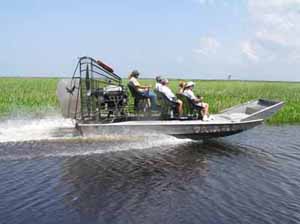LISTENING TO KATRINA
PAGES IN THIS BLOG ARE RATED 'R' AND DO CONTAIN
PROFANITY, VULGARITY, GRAPHIC VIOLENCE, NUDITY,
SCENES OF HUMAN EMOTION, DEATH, DESTRUCTION, MAYHEM, AND VARIOUS
INDESCRIBABLE HORRORS.
PLAN - Get a Neck Safe
This page has a worksheet in the Workbook. Click this link for the worksheet: WB014.PDF
I am not the kind of person who actually likes to plan for 'worst case' scenarios, but Katrina has some very interesting lessons in that regard.
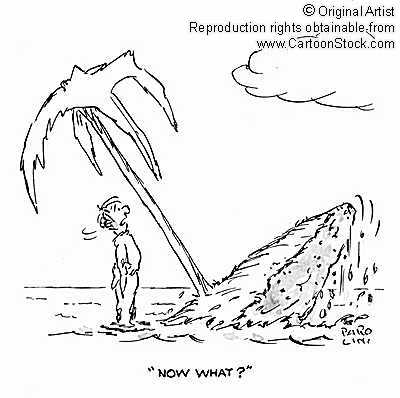 My grandfather was famous for saying, "The best laid plans of mice and
men often go astray." I heard this often in my boyhood. When I
was older and properly educated, one day I told him, "You know, that's
actually from a poem by Robert Burns called 'To A Mouse'. The line in
the original Scottish is 'The best laid schemes o' mice an' men Gang aft
agley'."
My grandfather was famous for saying, "The best laid plans of mice and
men often go astray." I heard this often in my boyhood. When I
was older and properly educated, one day I told him, "You know, that's
actually from a poem by Robert Burns called 'To A Mouse'. The line in
the original Scottish is 'The best laid schemes o' mice an' men Gang aft
agley'."
To which he said, "Son, an education is only valuable if it's useful."
While I frequently considered these bits of my grandfather's wisdom, it took
me a long time to fully appreciate them.
In Listening to Katrina in the context of the stories I collected from
rescuers and the stories I collected from those rescued, I started to think
about something that I had never thought about before. Preparations do
not come with a warranty. Even if you are well prepared
- as many people actually were - that's no guarantee. Even good plans
sometimes go astray. Or awry. Or whatever.
This section is about ACTION plans, and plans don't come with a warranty
either. Sometimes, despite your best effort and intentions, the
Unexpected Circumstances Monster rears its ugly head and chews your face
off. Part of our ACTION plans is not to anticipate every unforeseen
circumstance, but to prepare for the collapse of all of our plans and all of
our preps - which is something that can be very hard to do.
Fortunately, we can Listen to Katrina.
There are many paths to follow, and many anecdotes to tell. Let's start small, though, and work our way up. In talking with rescue teams, helicopter pilots, law enforcement personnel, Red Cross folks, and individual families, I've gained an appreciation for something that I had never before considered. As a parent, I will tell you that I would kill and die before I'd ever be separated from my children. Every parent will tell you that - but the Unexpected Circumstances Monster sometimes has other plans. If you are in a danger area and the helicopter drops a basket and they say they can only take one, then you're going to put your kid in the basket.
For one reason or another, children get separated from parents. During the aftermath of Katrina, it happened quite a lot. Families were separated and scattered. It happens, and sometimes you cannot control this. A ten year old might know his name and address, but he isn't likely to know the address and phone number for the family contact outside the danger zone. Even if you drill it into his head so that he can repeat it in his sleep, the shock and trauma of a disaster can render such memories faulty. Your three year old? Forget it. Children aren't the only group at risk. Persons with special needs or conditions - like Down's Syndrome, for instance, are also in danger. Persons with Alzheimer's for another. Remember that the Unexpected Circumstances Monster is frequently hungry. Anyone can become ill, injured, or otherwise incapacitated. Even you.
In the absolute worst case, someone will need to identify your body.
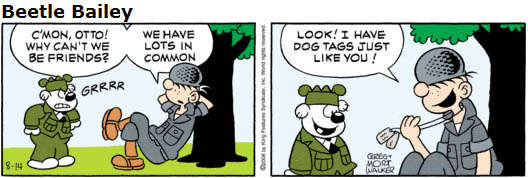
During the War of Northern Aggression, some soldiers pinned paper notes with their name and home address to the backs of their coats. Other soldiers devised other means of identification, and in 1906, the United States Army started issuing what has come to be called, 'dog tags'. Dog tags are stamped steel or aluminum tags with a few lines of embossed text. That's useful for identification, but we need something with more information. In the days after the storm, the ability to identify young children was a real problem for rescuers and law enforcement. Some of that task also fell to the Red Cross. In some cases children were rescued and it was later discovered the parents were dead - and that creates an entirely different set of problems.
Another circumstance is also apparent from the Katrina experience. Rescuers are not going to take your LGO bag. They are going to take you, and you're going to have to leave everything behind. You might get away with a very small bag (which I cover on the next page), but sometimes you may have to abandon even that. Many people were dropped at the Superdome, Convention Center, or at an interstate boat ramp with ABSOLUTELY NOTHING but the filthy, wet rags on their backs. This even happened to people that would have been considered 'well prepared' at the time because all their preps and plans collapsed entirely. Rich man, poor man, beggar man, thief. All same-same.
We need a plan and a physical preparation that will serve many functions:
1. Identification.
2. To provide contact information to facilitate family reunification.
3. To protect data wealth.
4. To provide immediate access to core aspects of the preparedness
plan.
5. To serve as a capsule for memory and identity. (I'll explain
that in a minute.)
6. To be useful otherwise in everyday life. (Because special
purpose things are often neglected.)
I also want this plan to be easy, cheap (really cheap!), durable, waterproof, and as small and light as possible.
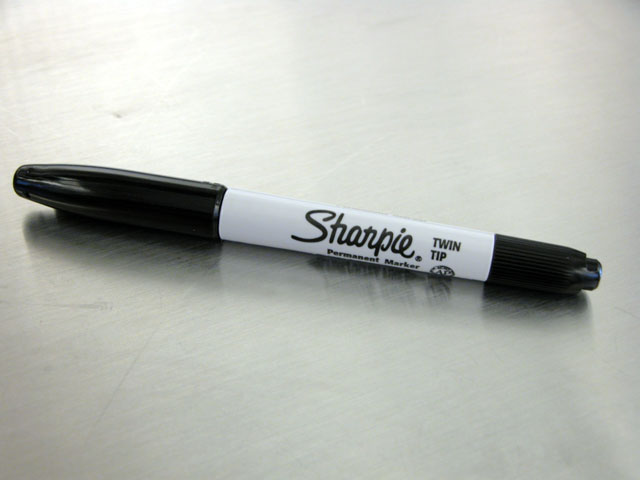 There
are several answers to this problem. The first answer is a permanent
marker, like a Sharpie. I like Sharpies, but any thick tipped
permanent marker will do. Writing your name and address on your arm as
the plane goes down isn't a new idea, but it works for us in this context
and is cheap, fast, easy, and workable. While workable, it doesn't do
much for you beyond identification - just like dog tags. We need to spend an extra few bucks and get something better.
There
are several answers to this problem. The first answer is a permanent
marker, like a Sharpie. I like Sharpies, but any thick tipped
permanent marker will do. Writing your name and address on your arm as
the plane goes down isn't a new idea, but it works for us in this context
and is cheap, fast, easy, and workable. While workable, it doesn't do
much for you beyond identification - just like dog tags. We need to spend an extra few bucks and get something better.
Answer number two is to implant microchips in the whole family. This is working well for pets, and many pets were returned to their owners after Katrina because of the microchips. It seems a little freaky to me, however, to implant microchips in my kids. If they came with GPS tracking, I might consider it...but I can't quite bring myself to it. It can also be expensive, and rescuers would have to have the reader and know that there was a chip in your shoulder to begin with. Sometimes the fancy technology is going too far...
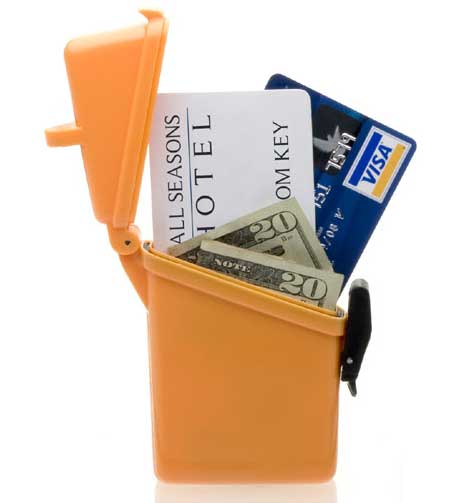
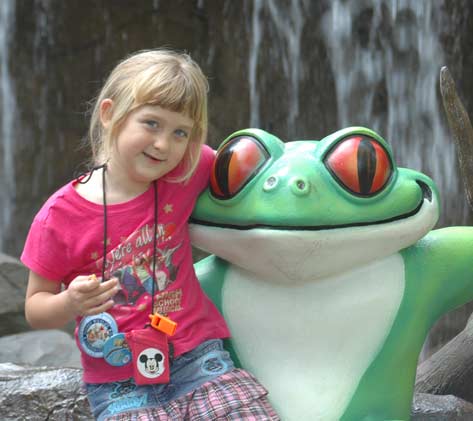 I found answer number
three before I completely contemplated the
problem.
While on a trip to Disney world, I wanted a way to let my 7 year old carry
her park pass and a little money around. I also wanted to be able to
look at her and know that she hadn't lost it. While passing through
the hotel gift shop on the first day, I noticed
Witz 'Surf Safe' cases. I thought,
"Well, that might work, but they're probably expensive." As it turns
out, they were six dollars - and simply brilliant. They fit all of our
criteria listed above. I immediately bought one for every member of
the family - even me. They come in eight colors, so order a different
color for each family member.
I found answer number
three before I completely contemplated the
problem.
While on a trip to Disney world, I wanted a way to let my 7 year old carry
her park pass and a little money around. I also wanted to be able to
look at her and know that she hadn't lost it. While passing through
the hotel gift shop on the first day, I noticed
Witz 'Surf Safe' cases. I thought,
"Well, that might work, but they're probably expensive." As it turns
out, they were six dollars - and simply brilliant. They fit all of our
criteria listed above. I immediately bought one for every member of
the family - even me. They come in eight colors, so order a different
color for each family member.
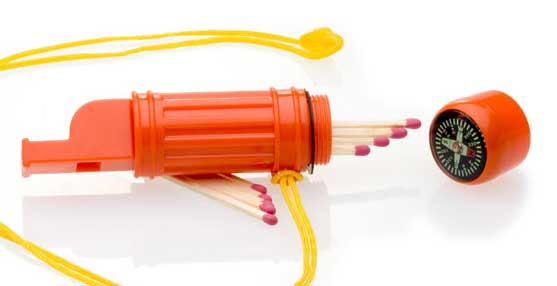 While I really like and strongly recommend the
'Surf Safe' cases, there are some
other solutions. They make an 'emergency case' which has a whistle and
a compass. This is a little gagety for me, but might be cool for the
kids. They make larger cases (which are too large, IMO). There are also some cheap-cheap ID holders with Zip-Loc style
closures that would work - but those are nearly as much as the Surf Safe.
While I would really like one just a tiny bit wider (as wide as
money folded in half), the Surf Safe really does blow everything else out of the water (so to
speak) so spend the
six bucks.
While I really like and strongly recommend the
'Surf Safe' cases, there are some
other solutions. They make an 'emergency case' which has a whistle and
a compass. This is a little gagety for me, but might be cool for the
kids. They make larger cases (which are too large, IMO). There are also some cheap-cheap ID holders with Zip-Loc style
closures that would work - but those are nearly as much as the Surf Safe.
While I would really like one just a tiny bit wider (as wide as
money folded in half), the Surf Safe really does blow everything else out of the water (so to
speak) so spend the
six bucks.
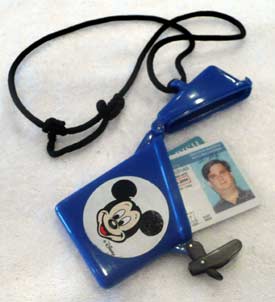
Let's talk about the container itself for a minute. I'm going to focus on the 'Surf Safe' case, but all of this applies to similar things. We have come to call these 'neck safes' in our family, so that is the terminology I'm going to use from here on out. No matter which type you have, that's what it is - a neck safe.
If you order them online, you may have a choice between a lanyard and a clip (like a small carabineer). Get the lanyard. This is a stand alone item. You aren't going to be clipping it to anything. (They have actually just started shipping them with both clips and lanyards, so you may not have an option.)
I have found the best thing to do is to wear it around your neck under your shirt. The problem with the lanyard is that it fastens with a cheap plastic break-away clip that is supposed to keep you from hanging yourself. This clip is worthless and will cause you to lose the case, so cut it off and melt the ends of the cord with something hot and tie them together. The instructions specifically warn against this, but the break-away clip is absolute junk. Get rid of the cheap metal ring that comes with the case and thread the lanyard through the hole directly. If you're fancy with knots, you can tie a double tautline hitch and make the lanyard adjustable. In order to keep the little rubber gasket around the lid in good shape, you can squirt a little Armor All or similar product onto a Q-Tip and clean and protect it easily.
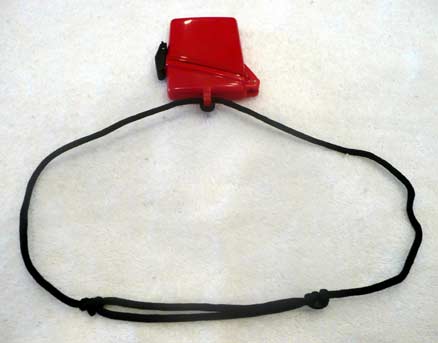 The next thing to do is write the owner's name on the neck safe with a
permanent marker. If you happen to be handy and you own an engraver,
you can engrave everyone's name into the plastic quite easily. Be sure
that you let little kids pick their color first. If you fail to do
this and engrave your kid's names onto them before they get to pick,
everyone will want a different color and you will lose points in the
'favorite parent' poll. You can also solve this by having the same
color for all the kids - but that might get confusing. Once they've chosen their color, do write or
engrave their name and address on the case itself. That way even if
the contents are lost, the case itself serves as an ID tag.
The next thing to do is write the owner's name on the neck safe with a
permanent marker. If you happen to be handy and you own an engraver,
you can engrave everyone's name into the plastic quite easily. Be sure
that you let little kids pick their color first. If you fail to do
this and engrave your kid's names onto them before they get to pick,
everyone will want a different color and you will lose points in the
'favorite parent' poll. You can also solve this by having the same
color for all the kids - but that might get confusing. Once they've chosen their color, do write or
engrave their name and address on the case itself. That way even if
the contents are lost, the case itself serves as an ID tag.
The neck safe is a cool gadget, so involving your kids (and your spouse!) in decorating them with stickers or markers or something is one of those fun family touchy-feely things that serves several purposes. If you have a spouse that is against all this 'crazy paranoid preparation crap', this is a good opportunity to engage them - especially if you have kids. "Well, gee, honey. You wouldn't want to lose the kids, would you?", is just the kind of parental guilt trip that works. Second, by involving the kids you're not just giving them something that they have to wear around their neck like a millstone. You're making it fun, and they're making the neck safes their own. Once decorated, they will also be hard to mistake. If you see a stranger walking around with your kid's neck safe, you can be 100% certain that you can clock the stranger with something heavy and you'll be in the right.
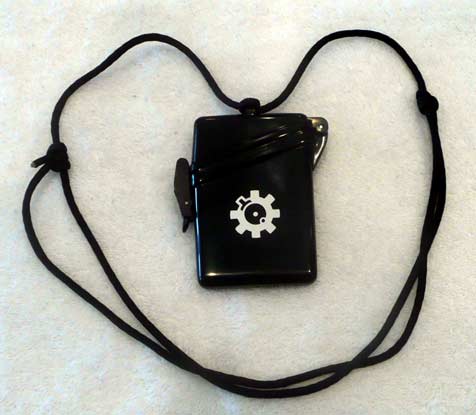 I
have a black one and installed some tacticool options on mine - like
swapping the shoelace lanyard for 550 paracord. I attach a whistle to
my daughter's lanyard for an emergency signal. She is old enough to be
responsible enough with this that she doesn't drive me crazy with the
whistle...
I
have a black one and installed some tacticool options on mine - like
swapping the shoelace lanyard for 550 paracord. I attach a whistle to
my daughter's lanyard for an emergency signal. She is old enough to be
responsible enough with this that she doesn't drive me crazy with the
whistle...
The primary reason for engaging the kids (and the spouse!) is to talk to them about what the neck safe is, what it's for, and how to use it. I have a lot of success with my 7 year old on this, but the three year old not so much. I have a slightly different strategy with the three year old.
Well, what IS the neck safe? What IS it for, and how DO you use it?
The neck safe is a container for wealth. Just like our Life Goes On Bag contains various kinds of wealth, our neck safes are smaller clones of the same concept. There isn't much space in a neck safe, so we'll have to be economic in our use of that space. The first thing to do is create a single page for identification and contact information. This is where the worksheet comes in: WB013.PDF You don't have to use my worksheet. You can write the information clearly and legibly on any sheet of paper, or create your own.
We should next consider photographs. If you're looking for someone, a photograph is a huge help. School photos are good for this, and seem to be just the right size. You can also make your own using your digital camera and some photo paper. You should write the person's name and the date of the photo on the back of the photo. Parents should carry a photo of each child, and children should carry photos of each parent and perhaps siblings as well. Depending on who lives in your home, you may also want to include photos of grandma, grandpa, uncle Joe, or other members of your household. One slick trick is to print the photos on the back of the contact information worksheet. Photos provide positive identification, and can help in a search for a child or other family member.
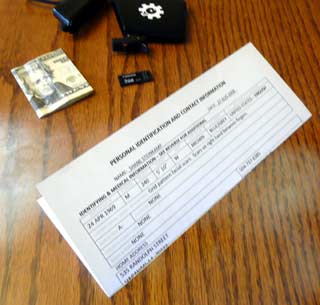 Once you have filled out the sheet for each person and printed photos, we
need to fold the paper in such a way that it fits neatly into whatever
container we have prepared. In order to fit the paper into the Witz
case we want to fold the paper so that it is just the same size as a credit
card or driver's license. In order to do that, trim off the bottom of
the page along the dotted line as indicated, and fold it in thirds like in
the picture. Make sure the top of the page is visible as shown.
Once you have filled out the sheet for each person and printed photos, we
need to fold the paper in such a way that it fits neatly into whatever
container we have prepared. In order to fit the paper into the Witz
case we want to fold the paper so that it is just the same size as a credit
card or driver's license. In order to do that, trim off the bottom of
the page along the dotted line as indicated, and fold it in thirds like in
the picture. Make sure the top of the page is visible as shown.
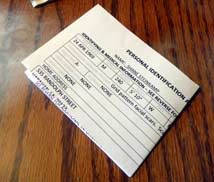
Now fold that in half, and fold the edges into the center.
At this point we can start including things. I include a 2GB Transcend Flash Drive with a copy of all the digital data wealth I showed you how to assemble earlier in this blog. At the time of this writing, you can get 2GB Transcend drives for less than eight bucks. Each member of the family carries a full copy. You can also include additional photographs, identifying documents, and medical information on the flash drive. You should not encrypt this so that it will be accessible to medical and law enforcement personnel. Everything else can be encrypted if you like, but leave the additional photos and medical documentation where someone can access it if they need to. By the age of 6 or 7, children should be taught the password to open the encrypted files. If you are killed or incapacitated and you were the only person who knew the password, then all that data is lost.
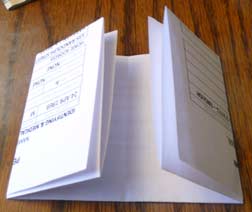
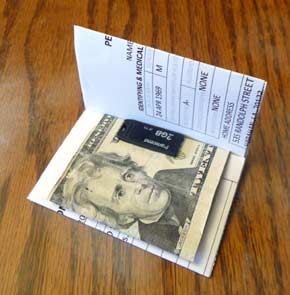 Cash money shouldn't be overlooked. It is my opinion that adults
should carry a $100 bill in their neck safes, and children should carry a
$20 bill or some amount appropriate for their age, with the understanding that this is money for a dire emergency
only. If they blow it on bubble gum one day, you're going to have to
get heavy on the discipline.
Cash money shouldn't be overlooked. It is my opinion that adults
should carry a $100 bill in their neck safes, and children should carry a
$20 bill or some amount appropriate for their age, with the understanding that this is money for a dire emergency
only. If they blow it on bubble gum one day, you're going to have to
get heavy on the discipline.
Assemble the ID paper, flash drive, and money together and wrap them tightly in some plastic wrap. Not so much for waterproofing, but to keep it all together. This is especially important for the kids, because they will lose and scatter things quickly. If you make a neat bundle out of it, they can carry and use their neck safes to carry other money or other items of that size - like park passes when you take them to Disney World.
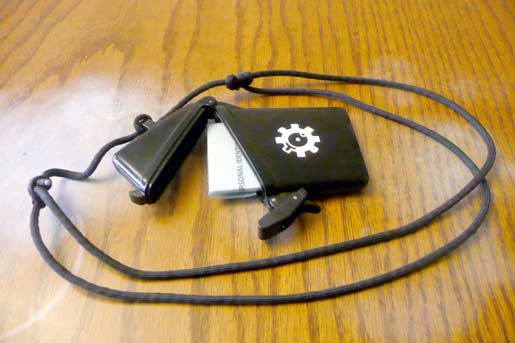 If
you've folded it correctly, it shows PERSONAL IDENTIFICATION at the top.
Very neat.
Another item that you can put into the neck safe is critical medication.
Of course, this is going to have to be something small, like a
nitroglycerine pill for heart attacks or something - but it is possible.
If
you've folded it correctly, it shows PERSONAL IDENTIFICATION at the top.
Very neat.
Another item that you can put into the neck safe is critical medication.
Of course, this is going to have to be something small, like a
nitroglycerine pill for heart attacks or something - but it is possible.
While I assume that I will always have my wallet with me, that's not guaranteed either. Some credit card companies will issue a duplicate credit card, and I keep the duplicate in my neck safe. When I renew my driver's license, I go back to the DMV the next week and claim to have lost it and I get another one. I keep the spare in the neck safe. If you don't want to go through that trouble, make a nice color copy of your driver's license (front and back) with your scanner and printer and keep that in the neck safe.
If you have created the neck safe exactly as I have done so here, you will find that your total cost (less the cash) is less than $15 per person. That's what it costs, but can you tell me what it's worth? For 15 dollars each, you can have a durable, waterproof case that you can wear around your neck that contains all your photographs, all your important documents, and all the other data wealth you have accumulated on your memory key (USB Flash Drive). EVERY family member will have this, along with positive identification, local and remote contact information, a small amount of cash, and a few other things.
This fulfils our design concepts of easy, cheap, durable, waterproof, small, and light. It also fulfils our design criteria of providing identification, contact information to facilitate family reunification, protecting data wealth, and to serve as a capsule for memory and identity.
Let me explain that.
Let's say that something terrible happens and one of your children is rescued, but the rest of your family doesn't make it. That child is cut adrift in the world, and while he or she may be found and raised by a remote family member, chances are that the child will grow up with many questions - questions that could be answered by the contents of the neck safe.
In the best case scenario, everyone is rescued. Now what? Each member of the family has immediate access to core aspects of the preparedness plan - you know who to call to start to coordinate your efforts. If you have the neck safe, then the contents of that neck safe serve as a seed. A seed you will need to nurture to find home again. Hopefully you will never need it, but you can ask more than 60,000 victims of Hurricane Katrina what it's like NOT to have such a seed. I have asked them, and the look in their eyes is all the answer you need.
Shane
